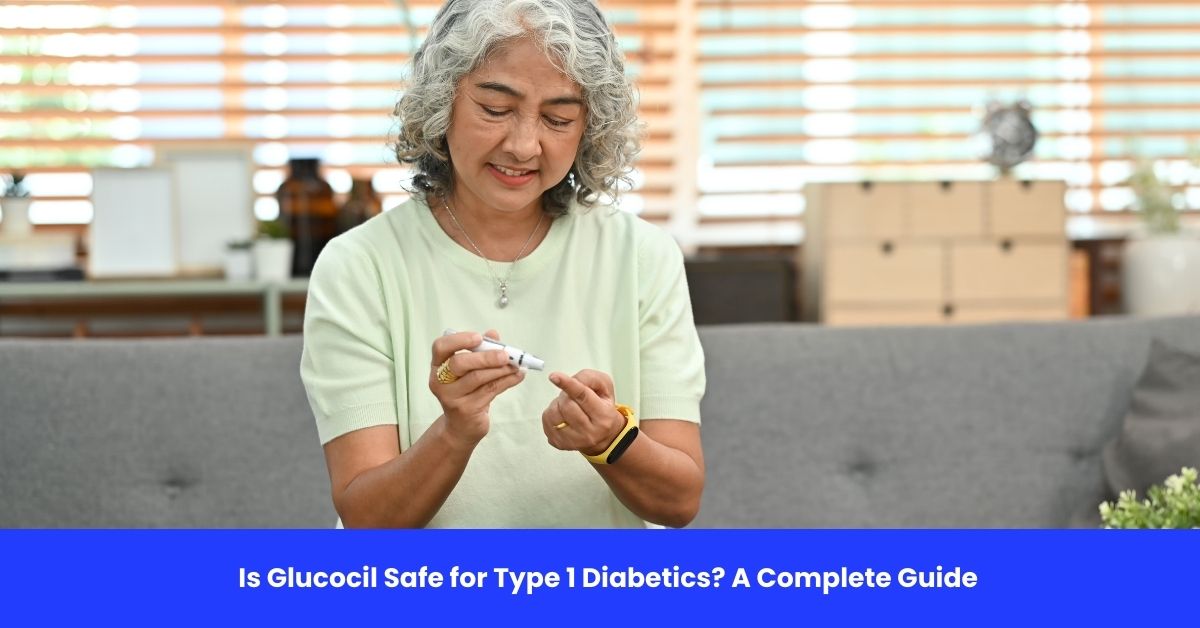Managing type 1 diabetes requires careful attention to blood sugar levels, insulin use, and overall health. Alongside conventional treatments like insulin therapy, many people with diabetes turn to dietary supplements like Glucocil in hopes of better managing their condition. However, one important question remains—is Glucocil safe for type 1 diabetics?
Glucocil is marketed as a natural supplement that supports healthy blood sugar levels. But for individuals with type 1 diabetes, who rely on insulin therapy to manage their blood sugar, can this supplement be a safe and effective addition to their diabetes management plan?
In this blog post, we’ll dive deep into the science behind Glucocil, how it works, its safety for type 1 diabetics, potential benefits, risks, and what experts have to say about using it. By the end, you’ll have a clear understanding of whether Glucocil could be a valuable part of your diabetes care.
What Is Glucocil?
Understanding Glucocil and Its Ingredients
Glucocil is a dietary supplement formulated to support healthy blood sugar levels. It is often marketed to people with type 2 diabetes, but it’s important to understand how its ingredients work before considering its use in managing type 1 diabetes.
The key ingredients in Glucocil include:
- Chromium: This mineral helps improve insulin sensitivity, allowing the body to use insulin more effectively. This could support glucose metabolism and potentially lower blood sugar levels.
- Berberine: A compound derived from several plants, berberine has been shown to help regulate blood sugar levels by improving insulin sensitivity and reducing glucose production in the liver.
- Alpha Lipoic Acid (ALA): A potent antioxidant, ALA helps reduce oxidative stress and inflammation, which are common issues in diabetes. It has also been shown to support insulin sensitivity.
- Cinnamon: Known for its ability to improve insulin sensitivity, cinnamon may help lower blood sugar levels and manage glucose fluctuations.
These ingredients are generally recognized for their benefits in supporting blood sugar regulation, but are they safe and effective for type 1 diabetics, who have a completely different mechanism for blood sugar management than type 2 diabetics?
How Does Glucocil Work?
Mechanism of Action
Glucocil’s effectiveness relies on its combination of natural ingredients, which work in various ways to support blood sugar control:
- Improving Insulin Sensitivity: Chromium and berberine are known for their ability to enhance insulin sensitivity. In type 2 diabetes, this helps reduce insulin resistance, but what about type 1 diabetics?
- Reducing Glucose Production: Berberine has been shown to reduce glucose production in the liver, a key factor in managing high blood sugar. However, in type 1 diabetes, insulin is often insufficient or absent, meaning the body has trouble regulating blood sugar without external insulin.
- Antioxidant Protection: ALA and cinnamon are antioxidants that protect cells from oxidative stress, which can be heightened in diabetics due to high blood sugar. This protection may be beneficial for both type 1 and type 2 diabetics.
Given these mechanisms, Glucocil could potentially support healthy blood sugar levels, but its effectiveness for type 1 diabetics—who rely on insulin—requires more detailed consideration.
Is Glucocil Safe for Type 1 Diabetics?
Glucocil is generally not recommended for people with Type 1 diabetes.
Here’s why:
- Type 1 diabetes is an autoimmune condition where the body does not make insulin at all. Managing it requires insulin injections—no supplement can replace that.
- Glucocil is marketed mainly for people with Type 2 diabetes or prediabetes, where insulin resistance is the main issue.
- Since Glucocil can lower blood sugar, if someone with Type 1 diabetes takes it along with insulin, it could increase the risk of dangerous hypoglycemia (very low blood sugar).
Safety Considerations for Type 1 Diabetics
Type 1 diabetes is a condition in which the pancreas no longer produces insulin, requiring individuals to rely on insulin therapy. This is different from type 2 diabetes, where insulin resistance is the primary issue. For type 1 diabetics, insulin is critical to controlling blood sugar levels, and any supplement that affects blood sugar levels must be used with caution.
1. Potential Interaction with Insulin Therapy
Glucocil works by improving insulin sensitivity and supporting blood sugar regulation, which could affect the amount of insulin a person needs. For type 1 diabetics who are already on insulin, adding Glucocil without proper monitoring may lead to an increased risk of hypoglycemia (low blood sugar). It’s important to work closely with a healthcare provider to adjust insulin doses if using Glucocil.
2. Risk of Hypoglycemia
Because Glucocil can help lower blood sugar levels, it’s essential to monitor blood sugar levels regularly. If you are a type 1 diabetic using insulin, adding Glucocil could lower your blood sugar too much, especially when combined with insulin therapy. Symptoms of hypoglycemia include dizziness, confusion, shaking, and even fainting, so it’s crucial to have a plan in place for managing low blood sugar.
Potential Benefits of Glucocil for Type 1 Diabetics
Although Glucocil is not a replacement for insulin therapy, it may offer some benefits when used as part of an overall diabetes management plan. Here are some potential benefits:
1. Supporting Blood Sugar Control
The ingredients in Glucocil may help with managing blood sugar by improving insulin sensitivity and reducing insulin resistance, both of which could assist with maintaining blood sugar levels within a healthy range.
2. Reducing Oxidative Stress
High blood sugar levels in type 1 diabetics can lead to increased oxidative stress, which contributes to complications like nerve damage (neuropathy) and cardiovascular issues. The antioxidant properties of alpha-lipoic acid and cinnamon in Glucocil may help reduce this stress, providing potential long-term benefits for type 1 diabetics.
3. Support for Metabolic Health
While Glucocil is not a substitute for insulin, it could offer additional support by improving the body’s response to insulin, potentially making it easier for people with type 1 diabetes to manage their condition.
Risks of Taking Glucocil for Type 1 Diabetics
1. Risk of Over-Lowering Blood Sugar
For type 1 diabetics, taking Glucocil could increase the risk of low blood sugar (hypoglycemia). Since Glucocil works to lower blood sugar, if used alongside insulin, it could lead to blood sugar levels dropping too low, which can be dangerous without proper intervention.
2. Drug Interactions
Glucocil’s ingredients, such as berberine and cinnamon, may interact with certain diabetes medications, including insulin. If you are taking other medications for diabetes, it is essential to check with your healthcare provider before starting Glucocil to ensure there are no adverse interactions.
3. Gastrointestinal Side Effects
Some people may experience gastrointestinal issues, such as nausea or diarrhea, especially when taking high doses of Glucocil. Type 1 diabetics with sensitive stomachs or digestive issues may want to start with a smaller dose to avoid discomfort.
Expert Recommendations
Consulting with a Healthcare Provider
Before incorporating Glucocil into your diabetes management plan, it’s essential to consult your doctor. A healthcare provider will be able to assess your overall health and determine whether Glucocil is safe for you to use alongside your insulin therapy. They can also help monitor your blood sugar levels and make necessary adjustments to your treatment plan.
Start with a Low Dose
If your healthcare provider approves the use of Glucocil, it’s advisable to start with a lower dose to gauge your body’s response. Since Glucocil may affect blood sugar levels, careful monitoring is essential to ensure you’re not experiencing hypoglycemia or other adverse effects.
Regular Blood Sugar Monitoring
If you’re a type 1 diabetic using insulin, it’s crucial to monitor your blood sugar levels regularly, especially when adding new supplements like Glucocil to your routine. Keeping track of your blood sugar will help you and your healthcare provider adjust your insulin dosage and avoid potential complications.
Real-Life Scenario
Ramesh’s Experience with Glucocil
Ramesh, a 52-year-old engineer from Bengaluru, started using Glucocil after reading about it online.
“At first, I was skeptical, but I wanted to see if it could help with my blood sugar spikes after meals,” Ramesh shares.
After three months, Ramesh noticed slight improvements in his post-meal glucose levels but emphasized that the supplement worked best when paired with regular exercise and a balanced diet. “It’s not a miracle cure, but it’s a helpful addition,” he adds.
Ramesh’s story highlights the importance of using supplements like Glucocil as part of a comprehensive health plan, rather than relying on them as a primary solution.
Expert Contribution
Insights from Dr. Priya Sharma, Endocrinologist
Dr. Priya Sharma, an endocrinologist based in Delhi, weighs in on the safety and efficacy of supplements like Glucocil for non-diabetics.
“Supplements can offer additional support, but they are not a substitute for prescribed medications or lifestyle changes. Ingredients like chromium and alpha-lipoic acid have shown promise in studies, but their effects can vary among individuals,” Dr. Sharma explains.
Dr. Sharma advises patients to discuss supplements with their doctors to avoid interactions with medications or potential side effects, particularly for those who are not diabetic.
Recommendations Grounded in Proven Research and Facts
If you’re considering taking Glucocil, keep these tips in mind:
1. Consult Your Doctor
Always discuss supplements with your healthcare provider to ensure they are safe and won’t interfere with your medications or treatment plan.
2. Start with a Small Dose
Begin with the recommended dosage and monitor your body’s response. Watch for side effects and discontinue use if necessary.
3. Focus on Lifestyle Changes
Supplements work best when combined with:
- Healthy Eating: A diet rich in whole grains, vegetables, lean proteins, and healthy fats.
- Regular Exercise: Walking, yoga, or light cardio can improve insulin sensitivity.
- Stress Management: Practices like meditation or deep breathing can stabilize blood sugar levels.
4. Monitor Your Blood Sugar Levels
Track your blood sugar regularly to see if Glucocil or other supplements are making a positive impact.
5. Avoid Over-Reliance on Supplements
Remember that supplements are just one piece of the puzzle. Medications, diet, and exercise remain the cornerstones of diabetes management.
Frequently Asked Questions (FAQs) on Is Glucocil Safe for Type 1 Diabetics?
1. Is Glucocil Safe for Type 1 Diabetics?
Glucocil may be safe for type 1 diabetics when used cautiously and under the guidance of a healthcare provider. Since it can affect blood sugar levels, regular monitoring and potential adjustments to insulin doses are necessary to avoid complications.
2. Can Glucocil Replace Insulin for Type 1 Diabetics?
No, Glucocil cannot replace insulin for type 1 diabetics. Insulin therapy is critical for managing blood sugar in type 1 diabetes, and Glucocil should only be used as a supplement to support blood sugar regulation, not as a replacement for insulin.
3. How Does Glucocil Work for Type 1 Diabetes?
Glucocil works by improving insulin sensitivity and supporting blood sugar control. The ingredients in Glucocil, such as chromium and berberine, may help the body respond more effectively to insulin, but they do not replace the need for insulin in type 1 diabetes.
4. Can Glucocil Cause Low Blood Sugar in Type 1 Diabetics?
Yes, Glucocil can potentially cause low blood sugar (hypoglycemia) when taken with insulin, as it works to lower blood sugar levels. Type 1 diabetics should closely monitor their blood sugar and adjust their insulin doses accordingly.
5. What Are the Side Effects of Glucocil for Type 1 Diabetics?
Some possible side effects of Glucocil include gastrointestinal discomfort (nausea, bloating, or diarrhea). Additionally, there is a risk of hypoglycemia, so it’s essential to monitor blood sugar levels closely.
Conclusion
Is Glucocil safe for type 1 diabetics? When used cautiously and under the guidance of a healthcare provider, Glucocil may offer benefits for type 1 diabetics, such as supporting insulin sensitivity and reducing oxidative stress. However, it should not replace insulin therapy and must be used alongside careful blood sugar monitoring and potential adjustments to insulin doses.
Always consult with your healthcare provider before adding any supplement to your diabetes management plan. With proper care and attention, Glucocil may be a helpful addition to your treatment routine, but it’s essential to prioritize your insulin therapy and overall health management.



